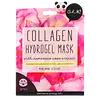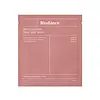Oh K! Hydrogel Mask Versus Biodance Real Deep Mask
What's inside
What's inside
 Key Ingredients
Key Ingredients

 Benefits
Benefits

 Concerns
Concerns

 Ingredients Side-by-side
Ingredients Side-by-side

Water
Skin ConditioningDipropylene Glycol
HumectantGlycerin
HumectantHydrolyzed Collagen
EmollientPalmitoyl Tripeptide-5
Skin ConditioningRosa Damascena Extract
MaskingCeratonia Siliqua Gum
EmollientChondrus Crispus Powder
AbrasiveChondrus Crispus Extract
Skin ConditioningPanthenol
Skin ConditioningCentella Asiatica Extract
CleansingPaeonia Suffruticosa Root Extract
Skin ProtectingChamomilla Recutita Flower Extract
MaskingBetaine
HumectantCellulose Gum
Emulsion StabilisingButylene Glycol
Humectant1,2-Hexanediol
Skin ConditioningPotassium Chloride
Algin
MaskingGlyceryl Caprylate
EmollientSucrose
HumectantSynthetic Fluorphlogopite
Sodium Polyacrylate
AbsorbentPolysorbate 20
EmulsifyingHydrogenated Polydecene
EmollientCalcium Aluminum Borosilicate
CI 77891
Cosmetic ColorantMica
Cosmetic ColorantDextrin
AbsorbentPantolactone
HumectantTrideceth-6
EmulsifyingSilica
AbrasiveTin Oxide
AbrasiveEthylhexylglycerin
Skin ConditioningCI 77491
Cosmetic ColorantDisodium EDTA
Parfum
MaskingWater, Dipropylene Glycol, Glycerin, Hydrolyzed Collagen, Palmitoyl Tripeptide-5, Rosa Damascena Extract, Ceratonia Siliqua Gum, Chondrus Crispus Powder, Chondrus Crispus Extract, Panthenol, Centella Asiatica Extract, Paeonia Suffruticosa Root Extract, Chamomilla Recutita Flower Extract, Betaine, Cellulose Gum, Butylene Glycol, 1,2-Hexanediol, Potassium Chloride, Algin, Glyceryl Caprylate, Sucrose, Synthetic Fluorphlogopite, Sodium Polyacrylate, Polysorbate 20, Hydrogenated Polydecene, Calcium Aluminum Borosilicate, CI 77891, Mica, Dextrin, Pantolactone, Trideceth-6, Silica, Tin Oxide, Ethylhexylglycerin, CI 77491, Disodium EDTA, Parfum
Water
Skin ConditioningGlycerin
HumectantAcrylates Copolymer
Niacinamide
SmoothingCeratonia Siliqua Gum
EmollientChondrus Crispus Extract
Skin ConditioningDipropylene Glycol
HumectantBetaine
HumectantAlgin
Masking1,2-Hexanediol
Skin ConditioningHydroxyacetophenone
AntioxidantButylene Glycol
HumectantPotassium Chloride
Agar
MaskingCaprylyl Glycol
EmollientSucrose
HumectantAllantoin
Skin ConditioningPolyglyceryl-10 Laurate
Skin ConditioningEthylhexylglycerin
Skin ConditioningGalactomyces Ferment Filtrate
HumectantAdenosine
Skin ConditioningDisodium EDTA
Pyrus Communis Fruit Extract
Skin ConditioningRosa Damascena Flower Water
MaskingCollagen Extract
Skin ConditioningIris Florentina Root Extract
MaskingCucumis Melo Fruit Extract
Skin ConditioningHedera Helix Leaf/Stem Extract
AntimicrobialDipotassium Glycyrrhizate
HumectantHydrolyzed Hyaluronic Acid
HumectantLactobacillus Ferment
Skin ConditioningBifida Ferment Filtrate
Skin ConditioningLactobacillus Ferment Lysate
Skin ConditioningTocopherol
AntioxidantWater, Glycerin, Acrylates Copolymer, Niacinamide, Ceratonia Siliqua Gum, Chondrus Crispus Extract, Dipropylene Glycol, Betaine, Algin, 1,2-Hexanediol, Hydroxyacetophenone, Butylene Glycol, Potassium Chloride, Agar, Caprylyl Glycol, Sucrose, Allantoin, Polyglyceryl-10 Laurate, Ethylhexylglycerin, Galactomyces Ferment Filtrate, Adenosine, Disodium EDTA, Pyrus Communis Fruit Extract, Rosa Damascena Flower Water, Collagen Extract, Iris Florentina Root Extract, Cucumis Melo Fruit Extract, Hedera Helix Leaf/Stem Extract, Dipotassium Glycyrrhizate, Hydrolyzed Hyaluronic Acid, Lactobacillus Ferment, Bifida Ferment Filtrate, Lactobacillus Ferment Lysate, Tocopherol
 Reviews
Reviews

Ingredients Explained
These ingredients are found in both products.
Ingredients higher up in an ingredient list are typically present in a larger amount.
1,2-Hexanediol is a synthetic liquid and another multi-functional powerhouse.
It is a:
- Humectant, drawing moisture into the skin
- Emollient, helping to soften skin
- Solvent, dispersing and stabilizing formulas
- Preservative booster, enhancing the antimicrobial activity of other preservatives
Algin is brown algae. Algae is an informal term for a group of aquatic organisms that can photosynthesize. It is estimated there are at least 30,000 types of Algae.
Algae contains antioxidants. Antioxidants help fight free-radicals. Free-radicals are molecules that may damage your skin cells, such as pollution.
Betaine is a common humectant (a substance that promotes retention of moisture). It's known to be gentle on the skin and can help balance hydration.
This ingredient is best for improving hydration and soothing irritated skin. Studies also show it helps even out skin tone.
Fun fact: Betaine is naturally created in the skin and body. The kind found within cosmetic products can be either plant-derived or synthetic.
Another name for betaine is trimethylglycine.
Learn more about BetaineButylene Glycol (or BG) is used within cosmetic products for a few different reasons:
Overall, Butylene Glycol is a safe and well-rounded ingredient that works well with other ingredients.
Though this ingredient works well with most skin types, some people with sensitive skin may experience a reaction such as allergic rashes, closed comedones, or itchiness.
Learn more about Butylene GlycolCeratonia Siliqua Gum is extracted from the seeds of the carob tree. You might know this ingredient as Carob Gum or Locust Bean Gum. It is used to stabilize other ingredients and improve the texture of products.
Carob gum is made up of long-chain polysaccharides. This makes it a natural thickener.
Yes! This ingredient comes from the seeds of a tree. The name 'Locust Bean Gum' can be misleading.
Learn more about Ceratonia Siliqua GumChondrus Crispus Extract comes from a red algae native to the northern Atlantic coasts of Europe and North America. It helps hydrate the skin and is rich in antioxidants.
The antioxidants in chondrus crispus include lutein and zeaxanthin. Lutein has the ability to filter blue light from screens.
Other contents of chondrus crispus include polysaccharides, peptides, and amino acids. These help hydrate the skin.
What's the difference between algae and seaweed?
Algae is a broad term that includes seaweed. Not all algae is seaweed.
Dipropylene Glycol is a synthetically created humectant, stabilizer, and solvent.
This ingredient helps:
Dipropylene glycol is technically an alcohol, but it belongs to the glycol family (often considered part of the ‘good’ alcohols). This means it is hydrating and gentle on skin unlike drying solvent alcohols like denatured alcohol.
As a masking agent, Dipropylene Glycol can be used to cover the smell of other ingredients. However, it does not have a scent.
Studies show Dipropylene Glycol is considered safe to use in skincare.
Learn more about Dipropylene GlycolDisodium EDTA plays a role in making products more stable by aiding other preservatives.
It is a chelating agent, meaning it neutralizes metal ions that may be found in a product.
Disodium EDTA is a salt of edetic acid and is found to be safe in cosmetic ingredients.
Learn more about Disodium EDTAEthylhexylglycerin (we can't pronounce this either) is commonly used as a preservative and skin softener. It is derived from glyceryl.
You might see Ethylhexylglycerin often paired with other preservatives such as phenoxyethanol. Ethylhexylglycerin has been found to increase the effectiveness of these other preservatives.
Glycerin is already naturally found in your skin. It helps moisturize and protect your skin.
A study from 2016 found glycerin to be more effective as a humectant than AHAs and hyaluronic acid.
As a humectant, it helps the skin stay hydrated by pulling moisture to your skin. The low molecular weight of glycerin allows it to pull moisture into the deeper layers of your skin.
Hydrated skin improves your skin barrier; Your skin barrier helps protect against irritants and bacteria.
Glycerin has also been found to have antimicrobial and antiviral properties. Due to these properties, glycerin is often used in wound and burn treatments.
In cosmetics, glycerin is usually derived from plants such as soybean or palm. However, it can also be sourced from animals, such as tallow or animal fat.
This ingredient is organic, colorless, odorless, and non-toxic.
Glycerin is the name for this ingredient in American English. British English uses Glycerol/Glycerine.
Learn more about GlycerinPotassium Chloride can be bad for oily skin and be bad for acne prone skin.
Sucrose is a natural sugar found in fruits, vegetables, and nuts. It is the main constituent of white sugar.
In skincare, sucrose is a humectant and can be a mild exfoliant.
Sucrose is hydrophilic, meaning it attracts water. This makes it an effective humectant and helps hydrate the skin.
Studies show sugars may worsen acne-prone skin due to it disrupting the skin's natural biome. We recommend speaking with a professional if you have any concerns.
In some products such as body scrubs, sucrose is used as an gentle exfoliant.
The term 'sucrose' comes from the french word for sugar, 'sucre'.
Learn more about SucroseWater. It's the most common cosmetic ingredient of all. You'll usually see it at the top of ingredient lists, meaning that it makes up the largest part of the product.
So why is it so popular? Water most often acts as a solvent - this means that it helps dissolve other ingredients into the formulation.
You'll also recognize water as that liquid we all need to stay alive. If you see this, drink a glass of water. Stay hydrated!
Learn more about Water